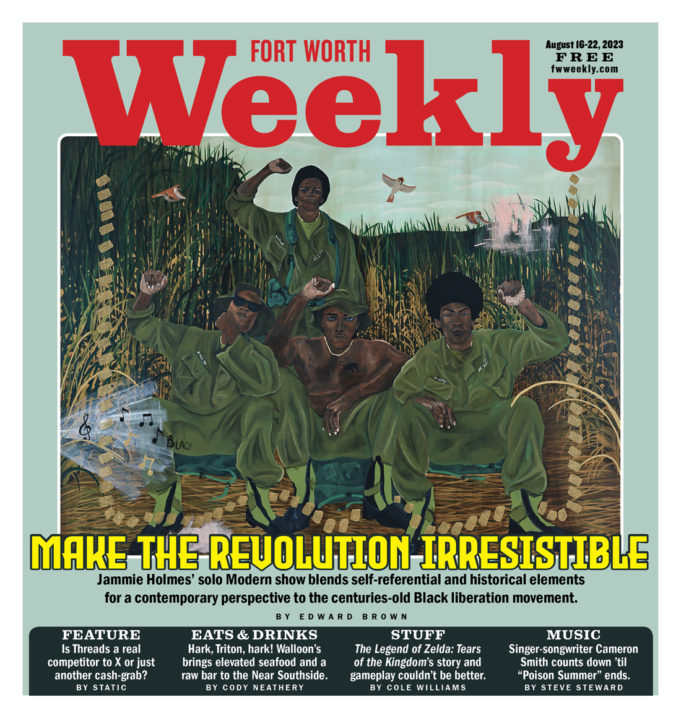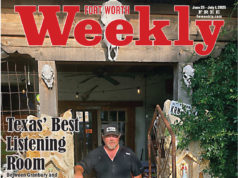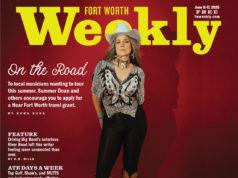America’s white power structure has historically resorted to violence as a first and last means of quelling Black-led movements seeking social and economic equality.
Take Black Panther leader Fred Hampton. His police-organized assassination in 1969 was as strategic as it was devastating to the working-class groups he was uniting. On the night of the raid, an FBI informant slipped a powerful sleeping agent into Hampton’s drink, leaving the 21-year-old incapacitated when police wounded him during the raid before shooting him twice in the head as he lay in bed.
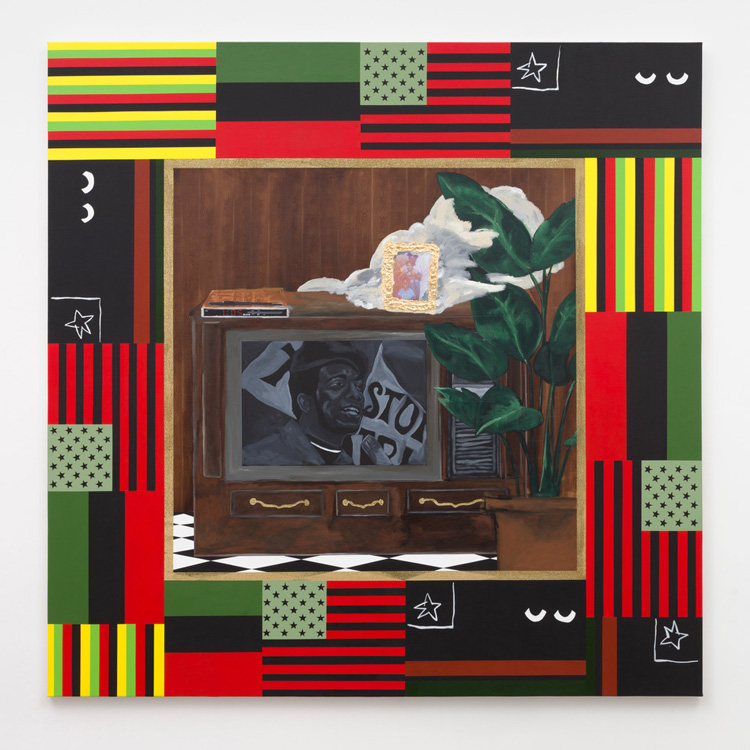
Courtesy the Modern
Through late November at the Modern Art Museum of Fort Worth, the geometrically surreal oil painting “Fred Hampton” can be viewed alongside over a dozen other, equally powerful paintings by Jammie Holmes as part of Make the Revolution Irresistible, the Dallas artist’s first solo show not only in a museum but in Texas. In the piece, the Black revolutionary resides in a position of reverence while reminding viewers that his core audience was working-class families. Framed in off-colored American flags and flags mimicking African nations, Hampton is shown on a black-and-white television set. Wearing his iconic beret, he looks rightward. The setting is a home with a potted plant on the right and framed pictures of three siblings above the TV.
Holmes is a relative newcomer. The 39-year-old Louisiana native cites the Modern’s 2016-2017 exhibit KAWS: WHERE THE END STARTS as his inspiration for pursuing a professional career in the arts. The museum spotlights 15 of his works that depict his hometown of Thibodaux, Louisiana, as well as historical figures and imaginative musings. Tying the pieces together is an unapologetic theme of marginalization of and police brutality against Black people in American society.
While many contemporary artists rely on a deep knowledge of archetypes and Western symbolism to convey meaning, Holmes paints largely figuratively with abstract references. “Just Like Your Father” shows a Black woman holding a young boy wearing a T-shirt reading “Rest in Peace.” The unsettling juxtaposition of what appears to be a loving family unit and untimely death speaks to the systemic issues, like police shootings, that unfairly cut short the lives of Black youths. Missing from the ominous garment is a face or name of the deceased, a reminder that the future is uncertain for many persons of color.
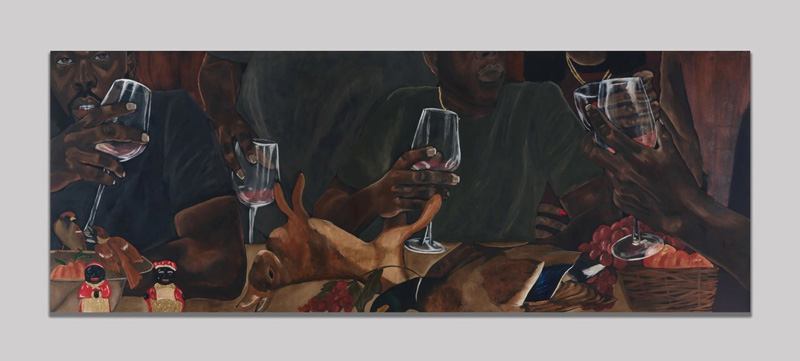
Courtesy Instagram
That’s not to say there aren’t metaphorical depths to plumb. “King’s Disease” is rich in symbolism. Four Black men sit at a large table with glasses of wine and loafs or bread, fruit, and wild game. The image evokes medieval murals and paintings of European royalty, but even in times of bounty, two blackface saltshakers add unease. Holmes places himself in the work, his stoic face failing to reveal his inner thoughts on the rhetorically spoiled lavish setting.
Make the Revolution Irresistible is not without its moments of triumph. “Lefty” harks to 1960s Vietnam as four Black soldiers, three of whom are seated, raise a fist in solidarity. Their postures and faces express pride and solidary. Back home, the Civil Rights movement was in full force. Musical symbols on the bottom left are reminders of the influence of activist-minded musicians at the time who fueled calls for equal voting rights and other reforms. Sparrows fly nearby, adding to the loftiness of the men’s fight overseas even as their brothers and sisters faced discrimination at home.
Holmes is a solid portrait artist, and the variety of his output keeps the exhibit engaging. Prominent Black artists like Kehinde Wiley have reframed a lot of Black Americans by placing them in regal positions a la Napoleon and other white conquerors. Holmes captures Black figures in commonplace settings as friends, siblings, and parents. Even that act is a reframing of perception as popular culture often establishes Blacks as instigators or recipients of violence.
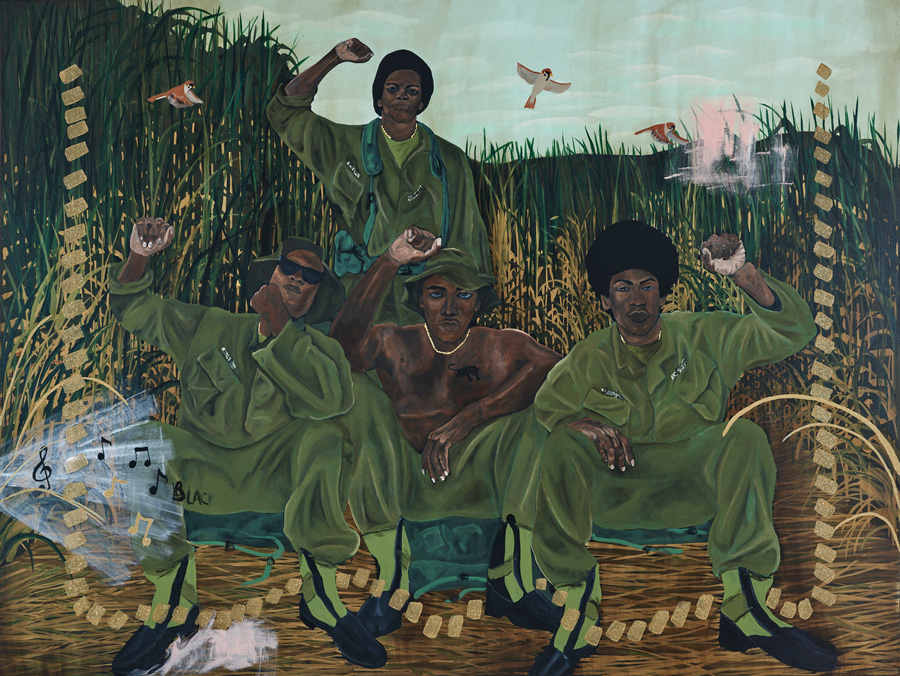
Courtesy the Modern
The most powerful elements of Make the Revolution Irresistible are its ties to the past. The pieces oscillate between history and modernity. Holmes is trying to better understand our society that is replete with strong Black revolutionaries yet beset by setbacks in the struggle for liberation. It is this journey that he, through his paintings, invites all to engage, reflect, and presumably act upon.
Jammie Holmes: Make the Revolution Irresistible
Thru Sun, Nov 26, at The Modern Art Museum of Fort Worth, 3200 Darnell St, FW. Free-$16. 817-738-9215.



